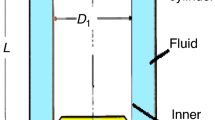Abstract
Purpose
The aim of this study was to compare the bulk lactose flow behavior with a defined fraction with smaller particles obtained by sieving from the bulk lactose and to evaluate the effect of a glidant addition on both samples. These powders showed, in a previous work, similar flow indexes (ffc) that motivated the addition of colloidal silicon dioxide in order to observe if there were any changes in their flow behaviors.
Methods
To evaluate this effect on the diluent flow behavior, the methods described in the European Pharmacopeia were used.
Results
The results obtained from conventional methods and shear cell methods (using the Powder Flow Tester) were compared, and they showed evident differences in the bulk and tapped densities values and flow classifications. The lactose monohydrate (FTotal) and lactose with particles smaller than 63 μm (F < 63) analyzed in a previous study presented similar ffc. To these pure powders a glidant was added, in increasing proportion (0.25—1.00%). The results obtained for all powders with colloidal silicon dioxide showed an improvement in its flow behaviors in comparison with pure powders.
Conclusion
All the parameters studied showed an evident effect of the glidant used. For the same amount of glidant, the F < 63 presented worse flow profiles than FTotal because its particles have a larger surface area. The FTotal + 0.25 flow profile was more similar to the F < 63 + 0.50 flow profile than F < 63 + 0.25 flow profile. For both powders, the maximum amount of glidant that produces effect was 1.00% for F < 63 and 0.75% for FTotal, respectively. In all powders, the occurrence of caking was not observed.







Similar content being viewed by others
Availability of Data and Material
Not applicable.
References
Von Behren DA. Physical characterization of excipients in practice. Pharm Technol. 1996;06:87–9.
Jonat S, Hasenzahl S, Gray A, Schmidt PC. Mechanism of glidants: investigation of the effect of different colloidal silicon dioxide types on powder flow by atomic force and scanning electron microscopy. J Pharm Sci. 2004;93:2635–44.
Li J, Wu Y. Lubricants in pharmaceutical solid dosage forms. Lubricants. 2014;2:21–43.
Rowe RC, Sheskey PJ, Weller PJ. Handbook of pharmaceutical excipients. 6th ed. London: Pharmaceutical Press; 2009.
Jones TM, Pilpel N. The flow of granular magnesia. J Pharm Pharmacol. 1966;18:429–42.
Gold G, Duvall RN, Palermo BT, Slater JG. Powder flow studies. 3. Factors affecting the flow of lactose granules. J Pharm Sci. 1968;57:667–71.
Salustio PJ, Machado M, Nunes T. Sousa e Silva JP, Costa PC. Lactose monohydrate flow characterization using shear cell method. Pharm Dev Technol. 2020;25(6):686–93.
Salustio PJ, Inacio C, Nunes T, Sousa e Silva JP, Costa PC. Flow characterization of a pharmaceutical excipient using the shear cell method. Pharm Dev Technol. 2020;25:237–44.
Schulze D. Flow properties of bulk solids. In: Schulze D, editor. Powders and bulk solids: Behavior, characterization, storage and flow. Berlin, Heidelberg, New York, Tokyo: Springer; 2008. p. 35–74.
Seppala K, Heinamaki J, Hatara J, Seppala L, Yliruusi J. Development of a new method to get a reliable powder flow characteristics using only 1 to 2 g of powder. AAPS PharmSciTech. 2010;11:402–8.
Horio T, Yasuda M, Matsusaka S. Effect of particle shape on powder flowability of microcrystalline cellulose as determined using the vibration shear tube method. Int J Pharm. 2014;473:572–8.
Jager PD, Bramante T, Luner PE. Assessment of pharmaceutical powder flowability using shear cell-based methods and application of Jenike’s methodology. J Pharm Sci. 2015;104:3804–13.
Shah RB, Tawakkul MA, Khan MA. Comparative evaluation of flow for pharmaceutical powders and granules. AAPS PharmSciTech. 2008;9:250–8.
2.9.16. Flowability. In: European Pharmacopoeia 9, EDQM Council of Europe (Ed.); 2017.
2.9.34 Bulk density and tapped density of powders. In: European Pharmacopoeia 9, EDQM Council of Europe (Ed.); 2017.
2.9.36. Powder flow. In: European Pharmacopoeia 9, EDQM Council of Europe (Ed.); 2017.
2.9.49. Powder flow properties by shear cell methods. In: European Pharmacopoeia 10, EDQM Council of Europe (Ed.); 2020
Shi LA, Chattoraj S, Sun CC. Reproducibility of flow properties of microcrystalline cellulose - Avicel PH102. Powder Technol. 2011;212:253–7.
Kuentz M, Schirg P. Powder flow in an automated uniaxial tester and an annular shear cell: a study of pharmaceutical excipients and analytical data comparison. Drug Dev Ind Pharm. 2013;39:1476–83.
2.9.35. Powder fineness. In: European Pharmacopoeia 9, EDQM Council of Europe (Ed.); 2017
Zhou Q, Armstrong B, Larson L, Stewart PJ, Morton DA. Improving powder flow properties of a cohesive lactose monohydrate powder by intensive mechanical dry coating. J Pharm Sci. 2010;99:969–81.
Faqih AM, Mehrotra A, Hammond SV, Muzzio FJ. Effect of moisture and magnesium stearate concentration on flow properties of cohesive granular materials. Int J Pharm. 2007;336:338–45.
Modugno C, Paterson AHJ, McLeod J. Lactose caking: influence of the particle size distribution and the water content. Procedia Eng. 2015;102:114–22.
Crouter A, Briens L. The effect of moisture on the flowability of pharmaceutical excipients. AAPS PharmSciTech. 2014;15:65–74.
Hou H, Sun CC. Quantifying effects of particulate properties on powder flow properties using a ring shear tester. J Pharm Sci. 2008;97:4030–9.
Guerin E, Tchoreloff P, Leclerc B, Tanguy D, Deleuil M, Couarraze G. Rheological characterization of pharmaceutical powders using tap testing, shear cell and mercury porosimeter. Int J Pharm. 1999;189:91–103.
Saw HY, Davies CE, Paterson AHJ, Jones JR. Correlation between powder flow properties measured by shear testing and Hausner ratio. Procedia Eng. 2015;102:218–25.
Wang YF, Koynov S, Glasser BJ, Muzzio FJ. A method to analyze shear cell data of powders measured under different initial consolidation stresses. Powder Technol. 2016;294:105–12.
Leung LY, Mao C, Srivastava I, Du P, Yang CY. Flow function of pharmaceutical powders is predominantly governed by cohesion, not by friction coefficients. J Pharm Sci. 2017;106:1865–73.
Lumay G, Boschini F, Traina K, Bontempi S, Remy JC, Cloots R, et al. Measuring the flowing properties of powders and grains. Powder Technol. 2012;224:19–27.
Acknowledgments
The authors would like to thank Dra. Teresa Malta and Atral, S.A., for the kindly supplying of the lactose monohydrate, that made this work possible.
Code Availability
Not applicable.
Funding
This work was supported by the Applied Molecular Biosciences Unit-UCIBIO, which is financed by national funds from FCT/MCTES (UID/Multi/04378/2019).
Author information
Authors and Affiliations
Corresponding author
Ethics declarations
Conflicts of Interest
The authors declare that they have no conflict of interest.
Additional information
Publisher’s Note
Springer Nature remains neutral with regard to jurisdictional claims in published maps and institutional affiliations.
Highlights
Raw-materials flow properties are important for handling/ of the powders/granulates.
The glidants improve these powder/granulates characteristics.
Powder flow was measured according with European Pharmacopeia methods.
CSD improved the flow behavior of the powders analyzed.
CSD amount to produce maximum effect is different for two powders used.
Results from conventional methods are inconsistent.
Results from Powder Flow Tester methods are more complete and reliable.
Rights and permissions
About this article
Cite this article
Salústio, P.J., Machado, M., Nunes, T. et al. Influence of the Glidant on Diluent Flow Characterization Using Shear Cell Method. J Pharm Innov 17, 60–70 (2022). https://doi.org/10.1007/s12247-020-09478-6
Published:
Issue Date:
DOI: https://doi.org/10.1007/s12247-020-09478-6




